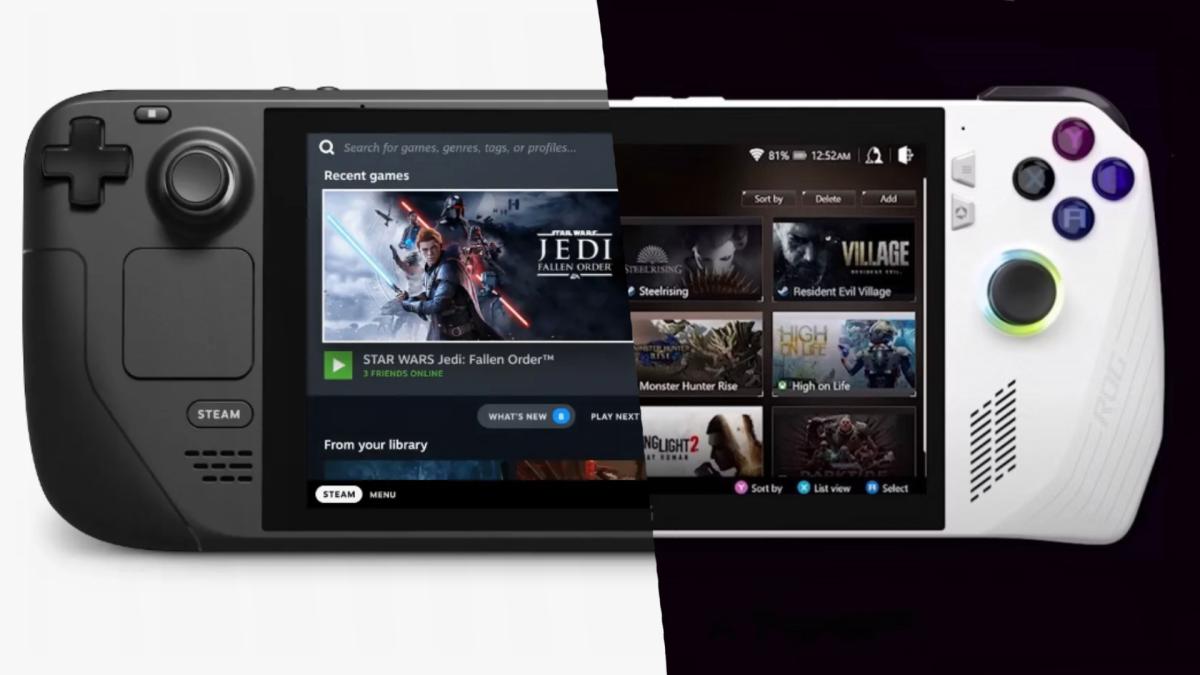Asus wants to take on the Steam Deck, but does the ROG Ally stack up?

Earlier this month, Asus announced its upcoming Steam Deck competitor, the ROG Ally. At the time, many thought it was an April Fool’s Day joke, given it was announced on April 1, but it turned out to be very real, and now we finally have some – but not all – of the hardware details.
Contents
- The Asus ROG Ally is smaller than the Steam Deck
- The Asus ROG Ally has a better screen than the Steam Deck
- The Asus ROG Ally and the Steam Deck have the same amount of storage
- The Asus ROG Ally is more powerful than the Steam Deck
- The Asus ROG Ally’s battery life will be about the same as the Steam Deck
- The Asus ROG Ally will likely be more expensive than the Steam Deck
Asus very clearly wants to knock the Steam Deck down a peg or two, but there are too many unknowns at this stage, with the big one being price. So far, Asus has stayed very quiet on the price of the ROG Ally, only telling PC Gamer that it will be “less than $1000”. How much less is anyone’s guess, but there’s a pretty big gap between the Steam Deck’s bottom end price of $399 and the Ally’s top end of $1000.
Thankfully, we do know the general specs of the Ally, so we can see how it stacks up in comparison to the Steam Deck from everything to size and weight to the raw performance stats. Here’s everything you need to know about the Asus ROG Ally compared to the Steam Deck.
The Asus ROG Ally is smaller than the Steam Deck
Look, on the whole, the Ally and the Deck are going to be roughly the same size, both of which being a bit chunkier than a Switch console. The Ally does have a slight advantage in that its screen size is about the same, but its body is very slightly smaller, with dimensions of 28 x 11.3 x 3.9cm, compared to the Deck’s 29.8 x 11.7 x 4.9cm.
The Ally is also a bit lighter, coming in at 608g, 61g lighter than the Deck’s 669g. 60 odd grams might not sound like much in the grand scheme of things, but when you’re talking about handheld devices, lighter is always better for longer gaming sessions.
The Asus ROG Ally has a better screen than the Steam Deck
There is absolutely no competition here, the Ally blows the Deck out of the water with its screen. As a refresher, the Steam Deck has a 7-inch LCD screen with a resolution of 1280x800 and a refresh rate of 60hz. It’s… fine, really, a lot of games running on the Deck hardware were probably not going to get above those stats anyway.
The ROG Ally seems to have shot for the moon with its display, which is also 7-inch, but it has a full 1080p screen, with a 120hz refresh rate. That means it’ll be sharper, smoother, and generally nicer to look at. Both are LCD, which obviously isn’t as nice as something like the Switch OLED’s, er, OLED screen, but it will absolutely get the job done, no matter what the job is.
The Asus ROG Ally and the Steam Deck have the same amount of storage
Well, kind of. The Ally comes with 512GB of built-in storage, which isn’t a great deal overall, but should be enough for the kind of games you’d want to be running on it. There is a variant of the Steam Deck that comes with the same amount of storage space, which costs $649. That’s a lot closer to the upper floor of the Ally’s potential price, but things get complicated there.
You could, instead, buy the base model Steam Deck, netting you 64GB of storage, then expand it with a Micro SD card. It won’t be quite as fast as the internal SSD, but if you pick a high quality card you probably won’t notice the difference. Even the most expensive Micro SD cards aren’t going to bring you up to $1000 all up, and you can usually grab 512GB Micro SD cards for as little as $50 during sales.
The Asus ROG Ally is more powerful than the Steam Deck
There’s a lot of raw numbers and terms we could throw at you here. The Ally is running an APU capable of 2.8Tflops compared to the Deck’s 1.6Tflops, the Ally has a fancy new AMD Ryzen Zen 4 Z1 processor compared to the Deck’s more modest Zen 2 APU, but none of that means anything to most people.
Coming down to brass tacks, the Ally should be about 50% more powerful than the Deck, or roughly a little more powerful than the PS4. Both have the same type and amount of RAM, so that won’t be much of a differentiating factor, but on paper the Ally seems better.

We say on paper because, well, it’s complicated. The Ally runs a version of Windows 11, and anyone who’s gamed on Windows knows that there’s usually a bit of overhead from the OS itself. The Deck on the other hand is running a slimmed down Linux that’s custom built for the hardware, eliminating a lot of overhead inherent in the process. That lack of overhead can be offset by ProtonDB, the translation layer that makes Windows games playable on Linux.
Which brings us to our next point, which is that compatibility is a huge deal, with not every game running on the Deck. Of course, not every game will run on the Ally either, but developers won’t have to put in any extra work to make their games compatible with the system. Generally speaking, if a game got a Windows release, it could theoretically be fiddled with enough to get going on the Ally.
We won’t know for sure how the raw numbers translate into real-world figures until the system is out and extensive testing and comparisons can take place.
The Asus ROG Ally’s battery life will be about the same as the Steam Deck
We don’t know the exact battery specs of the Ally yet, but Asus has said that it’s going to be roughly comparable to the Deck when running at the same TDP. Valve claims the Deck can get up to 8 hours of play, which is where we all throw our heads back and laugh for a bit. In the real world, you can get up to about 3 hours if you’re lucky, and some heavy games will drain the battery in 30 minutes flat.
The Ally is more powerful, but also more efficient, so you should be able to get the same battery life but better performance, in theory. You could also flip the switch the other way, getting better battery life, but the same performance as the Deck. Don’t expect miracles here either way — the Ally will not last as long as, say, a Nintendo Switch, no matter how you cut it.
The Asus ROG Ally will likely be more expensive than the Steam Deck
And this is what the comparison really boils down to in this conversation. With significantly better specs across the board, the Ally will almost certainly be more expensive than the Deck. We can’t envision a world where it somehow hits $400, and even getting it down to $650 seems pretty much impossible.
That said, with the specs the Ally is rocking, it just might be worth it. And if you live outside of the US or UK, there’s even more of an incentive to spend the extra cash, since the Steam Deck is notoriously difficult and expensive to get your hands on.
Writing from an Australian perspective, importing a 512GB Steam Deck costs around $1500 AUD, which converted is about… $1000 USD. So even if Asus is selling the Ally for $999 USD (still under $1000, if Asus wants to be a dick about it), local availability and the safety of a warranty that’s actually enforceable makes the Ally a very attractive option. If you’re in a region where the Deck is available, the Deck might still be a better option, as the pricing just won’t compare.
With so much still up in the air, it’s hard to know where the ROG Ally is going to land. But Asus has promised more details, including pricing, availability, and a release date, on May 11, so it won’t be long until we know for sure.
